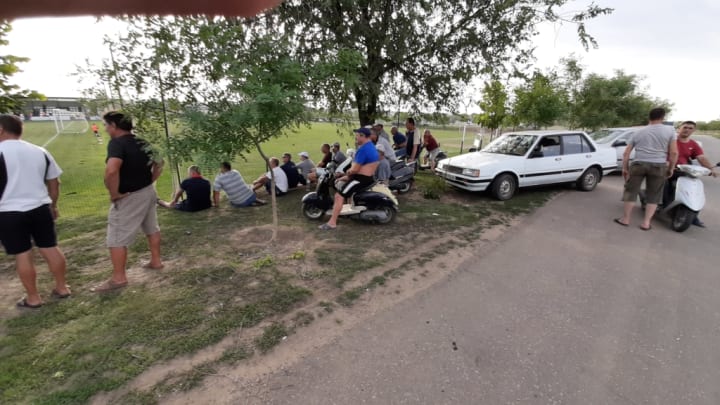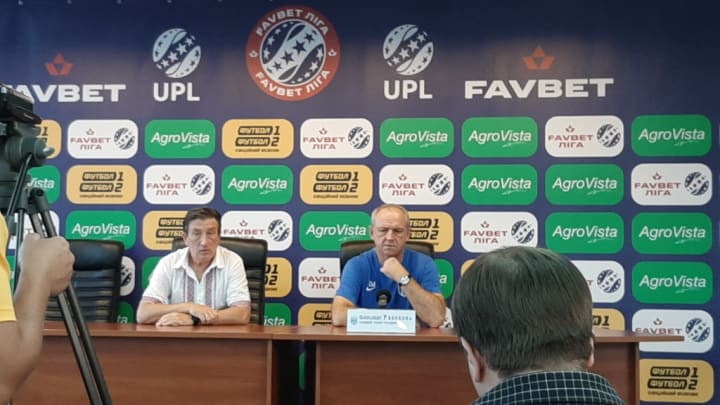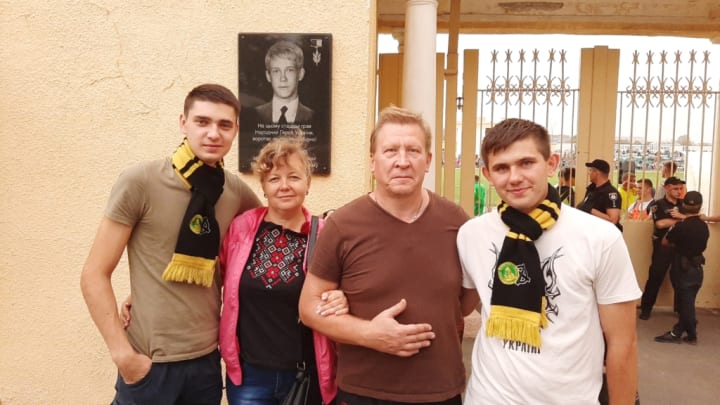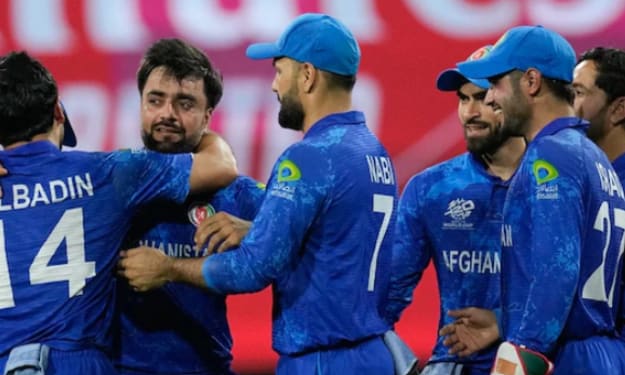Football in Ukraine
How a sporting odyssey took one fan deep into the heart of the country

To discover a new country without following the Tripadvisor template, ask a football fan. The beautiful game is universal, but exploring the highways and byways of the local championship offers a unique insight into a different – often hidden – world. Just ask Kyiv-based groundhopper Adam Pate, an exiled Sheffield United fan on a mission.
Before the start of the 2019/20 season, Adam and his girlfriend Natasha set out to see a game in all of Ukraine’s 24 regions, recording their adventures online. Despite the coronavirus lockdown curtailing the action, they managed to do it in 20 weeks, completing the epic road trip on December 15 in Dnipropetrovsk. Their journey took them all across this huge but little-known country, showing there’s more for the football fan than memories of Euro 2012 and the big hitters of Shakhtar Donetsk or Dynamo Kyiv, and also more for the tourist than onion-domed monasteries and the Chernobyl exclusion zone.
A Ukrainian ‘92 Club’
The idea was born last season, as Adam told the Groundhoppers blog. Frustrated with following Dynamo and curious to see more of his adopted homeland, Adam embarked on a few trips in authentic groundhopper fashion – hitting the road to see where the fixture list might take him. From lakeside barbecues in Rivne to one-horse towns hitting the big time thanks to a successful local businessman, he found a world full of fresh stories. The couple wanted to see more and decided to tick off each of the country’s regions, inspired by the 92 Club of fans who have been to every ground in the English Football League. It was the start of a voyage of discovery – starting with an obscure exclave deep in the south.

“Odessa was the first trip we did, but not to the city. We went to Zorya, this tiny little place west of Odessa itself,” Adam said. “As you go towards Moldova there’s a little bit of land that’s separate from the rest of Ukraine. You can only get there over a bridge, or going through Moldova. As soon as you get there, it feels like a different country. It’s called the Balkan peninsular and it was supposedly settled by Bulgarians.
“Balkany, the team in Zorya, used to be a village factory team but as they climbed the leagues they had to build a couple of stands. Even so, it backs onto a park and a lot of the old-time fans like to just pull up on their motorbikes on the other side of the road and watch the game from there. It’s like watching the English Championship but played on a parks pitch.”
That trip was also a first taste of how a visit from an English fan – with England still widely respected as the ‘motherland’ of football in much of the Russian-speaking world – had the locals rolling out the red carpet or, in Ukrainian terms, greeting their guests ‘with bread and salt’.
“The club invited us to their training session, so we went to the training complex there as well. That set the tone for a lot of our trips – people have made us so welcome.
“Often, they really went the extra mile to look after us. People wanted to talk to us about the project and know more about what we were doing. A lot of clubs were happy for us to use their press box and attend their press conferences. It was very strange; this English blogger turns up and people start rolling out the VIP treatment. We were in Oleksandriya a week before their first ever European match and was sitting in their press room interviewing the coaches from both teams! Quite a surreal experience.”

Cultural complications
Ukraine’s much-discussed geopolitics also cropped up along the way. The country’s position as a crossroads between Russia and Central Europe brings its own set of peculiarities. In Lviv, in the west of the country, communication could be a challenge for a Russian speaker. “The first time we went I tried to make contact with the head of their Ultras,” Adam recalled. “But I don’t speak Ukrainian, only Russian, and he wasn’t willing to help anyone in Russian.
“There are still very, very big differences between the regions and in the west there’s definitely a lot more national feeling. But these are interesting times across the country. It’s six years since the Maidan and Zelinsky’s rise to power. Quite a lot of attitudes that were seen as positives six or seven years ago are now maybe looked down on a bit.

“When you go to the Eastern regions, it’s much more Russian. It’s also a lot more industrial over there. But it’s not just an East/West split. When you go to Odessa, Kherson, Mykolayev, you immediately feel that you’re a lot further south. The architecture changes, more single storey buildings and fewer apartment blocks. Around the Black Sea it feels a lot more Mediterranean.”
From bucolic bliss to suffering and strife. Few places tell the tale of Ukraine’s recent troubles as starkly as Kramatorsk. This town, in the Donetsk Region right on the Russian border, was on the frontline of the military conflict that erupted in 2014 as the self-proclaimed Donetsk People’s Republic sought to swap the Kyiv government for the Kremlin. The fighting forced Shakhtar and Olimpik, the two top-flight teams from Donetsk, to relocate. In Kramatorsk, though, Avanhard is still in town – making for an emotional trip to the battleground.
“Kramatorsk was incredible, just seeing how the place has got back on its feet after being destroyed in the war,” Adam said. “We got a unique look at the place. We made contact with the heads of the Ultras and they agreed to show us around town. We ended up getting drunk with them and had a great day out.”
Ultras have a reputation for getting out of hand, but, on this occasion, decorum was maintained. “They could see that we were up for a laugh and luckily they behaved themselves. In the end they even let me lead the drumming in the second half!”

But beyond the beer and banners, there was a powerful story. In the early weeks of that conflict, Stepan Chubenko, a 16-year-old goalie on Avanhard’s books, was kidnapped by rebel forces and executed in a village on the outskirts of Donetsk city. His ‘crime’ was simply supporting the Ukrainian government over the rebels. Adam met Stepan’s parents, Viktor and Stalina, at the game – a sobering reminder of what city and club have been through. The Chubenkos remain in close contact with Avanhard, preserving the youngster’s memory through a monument at the Prapor stadium and publishing a book in his honour.
“The smile on the face of Stepan's Dad at the end of the game made me realise how much football bring relief to people, going through even the darkest of pain,” added Adam.
‘The Bilbao of Ukraine’
Ivano-Fransiysk was another highlight, with Prykarpattia’s game featuring a stadium that combined old Soviet tradition with a distinctive twist.

“It was definitely the most impressive stadium that we went to,” Adam said. “It was one of those old concrete bowls, typical of eastern Europe, with a real Soviet feel to it, but then they plonked a huge upper tier on top of two of the stands, completely open to the elements.
“When we visited there was just the one stand open, the other side is under complete reconstruction, but it was still a spectacular sight. We’d arranged with the club media officer to get pitchside and watch the game from there. When we arrived, the coach even broke off his team talk to give us a tour. We soon realised that his main aim was to show us the club shop and sell us some merchandise, and we were happy to oblige.”
Despite playing in the second tier, the team gets quite good crowds for that level. Typically 3-4,000 turn up for home games, attracted in part by a strict recruitment policy.
“They’re very proud of the fact that they only sign players from their region, they see themselves as a kind of Athletic Bilbao of Ukraine.”
The perils of UEFA
Many football fans know Ukraine best as the co-host of Euro 2012, an event that saw many of the country’s stadiums redeveloped or rebuilt. However, the local championship hasn’t been able to consolidate on a surge of interest in football and often it was the newer venues that were the least engaging. Kharkiv, which hosted games in 2012, and Dnepr, whose 21st-century arena didn’t make UEFA’s final shortlist, were two of the most disappointing trips.
“They were possibly the worst experiences we had at games,” Adam added. “In Kharkiv there was a crowd of 6,000 at a game in a 40,000-seater stadium. It was all a bit sad; you could even hear the shouts of the players across the pitch. Dnepr was rebuilt in 2010 and holds 30,000, but they only had about 3,000 in. They were bussing in the army to try to fill some of the seats.”
Those disappointments aside, Adam remains a committed advocate of Ukraine and its football culture, while also promoting the cause of his beloved Sheffield United on these foreign fields. And he has plans to share his adopted home with more groundhoppers from Britain once the coronavirus situation makes travel possible once again.
More to come
In recent years, groundhopping tours to different parts of Europe have become ever more popular – and Lviv could be the next hotspot for adventurous fans once things get back to normal.

“We want to do a groundhop in Lviv city in the autumn,” Adam said. “I was all set for my first game of the year on March 14 when the season should have started up again. I had a meeting scheduled with the head of the Lviv Football Federation to start making plans but it was the weekend when all the games were ordered behind closed doors and in the end we couldn’t travel.
“But we’ve had some interest in the idea and hopefully we’ll be able to make something happen in the future.”
For more details of Adam’s Ukrainian football adventures, check out his YouTube channel, or follow on Facebook or Twitter.
About the Creator
Andy Potts
Community focused sports fan from Northeast England. Tends to root for the little guy. Look out for Talking Northeast, my new project coming soon.
Enjoyed the story? Support the Creator.
Subscribe for free to receive all their stories in your feed. You could also pledge your support or give them a one-off tip, letting them know you appreciate their work.






Comments (1)
Well-written and informative! And perfectly timely. :) Thank you!